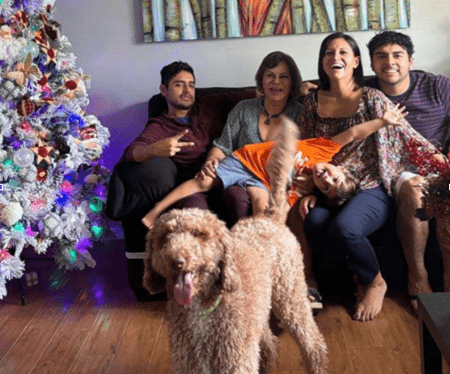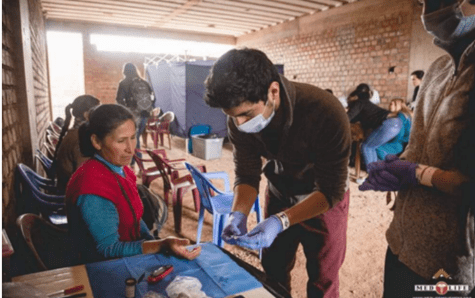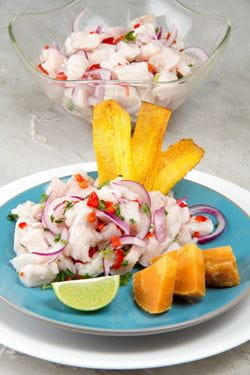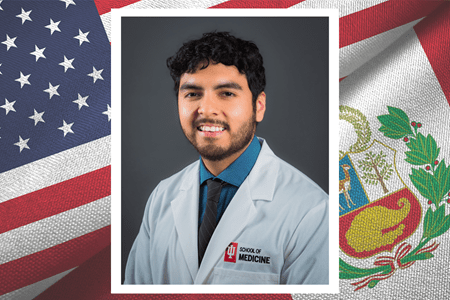Meet Evansville MD student Sebastian Castillo
Sebastian Castillo knows that for every struggle, there are personal strengths being forged. Although he was barely a toddler when his family immigrated from Lima, Peru to Charlotte, North Carolina, his cultural heritage continues to influence his path as a medical student at Indiana University School of Medicine—Evansville.
Castillo values cooperation and relates to people from underserved communities. His family’s story undergirds his passion for becoming a physician and breaking down barriers to medical care.
“Through my experiences, I gained a deep understanding of what it means to grow up in a low-income immigrant family,” Castillo said. “I learned firsthand the feelings of guilt that come from knowing everyone is trying their hardest, yet still struggling to make ends meet.”
Those same challenges, Castillo acknowledges, “instilled grit, determination and a strong work ethic.” His experiences have shaped who he is and where he is going.
‘Everyone has a part to play.’
Castillo came to the U.S. as a 1-year-old, along with his two teenage siblings, after their mother found work in Charlotte. While the family’s immigration opened opportunities in education and employment, it did not immediately remove the worries of food insecurity and homelessness his mother was trying to escape. The relocation also brought a new language and culture to learn.
“We faced these obstacles head on, working harder and building relationships from scratch,” Castillo said. “In our household, every one of us had a part to play in keeping our family moving forward. Even as a young child, I did whatever I could to help, whether it was tagging along with my mom to clean houses or standing guard at our small jewelry kiosk to make sure nothing was stolen.” The family moved often and shared cramped spaces, living with friends before they were able to purchase a home.
“Throughout this period, we remained frugal and resourceful — we relied on food stamps and Medicaid, and we shared a single car,” Castillo said. “While these limitations restricted our lifestyle, the strong bond and unity within our family brought us tremendous joy.”
 The family’s adversity compounded when his mother got sick. She underwent surgery for colon cancer and then survived a secondary bout with liver cancer. Through it all, she persevered, setting an example of resilience.
The family’s adversity compounded when his mother got sick. She underwent surgery for colon cancer and then survived a secondary bout with liver cancer. Through it all, she persevered, setting an example of resilience.
“I became especially grateful for the compassionate care we received, much of which came from community health centers and Federally Qualified Health Centers,” Castillo said. These government-funded medical clinics offer services on a sliding scale based on an individual’s ability to pay.
Despite his mother’s fortitude, Castillo could see the heaviness written on her face. As a child who wasn’t old enough to contribute to the family finances, he felt his most valuable contribution was often a simple hug, silently expressing, “I am with you.”
Although there are over a thousand miles between them now — from Evansville, Indiana, to south Florida where his mother now lives — Castillo still calls his mom every day.
“Those moments when I saw my mom struggling, but still trying so hard, are etched into me,” Castillo said. “I learned that by remaining consistent and united, and never giving up, success is achievable even in the face of adversity.”
Something his big sister, Claudia, told him long ago has stuck with him: “You can’t control the wind, but you can adjust the sails.”
Castillo took that to mean hardships will come, but he gets to choose how to direct his attitude and focus. He eventually followed his sister’s path toward a medical career. Today Claudia Isabella Tussey, MD, is a family medicine physician in Delray Beach, Florida.
“While I did have amazing familial support, I still had a lot of doubt in my own ability to make my dream a reality,” Castillo said. “I made academics a priority, and yet I felt very average. The doubt I had was always countered by family members that, oftentimes, believed in me even more than I believed in myself.”
Safeguarding children and strengthening families
As a student at Florida State University, Castillo majored in interdisciplinary medical sciences and seized an opportunity to participate in a service-learning trip back to his homeland with MEDLIFE, a nonprofit that connects student groups with low-income communities around the globe to bring dental and health care, education and housing security.
“The trip I participated in was to Cusco, Peru, where I played a role in organizing and setting up local mobile clinics across rural areas,” Castillo said. “This hands-on experience not only deepened my commitment to improving health care access for underserved populations, but it also reinforced my passion for community-driven health care initiatives.”
 His more recent experiences through AmeriCorps at IU School of Medicine have only deepened that passion. Last summer, Castillo volunteered with Holly’s House, an advocacy center in Evansville that provides support and resources to victims of intimate crimes and abuse. Castillo worked on a child abuse prevention initiative and developed his own research project to assess the effectiveness of sexual abuse prevention education programs.
His more recent experiences through AmeriCorps at IU School of Medicine have only deepened that passion. Last summer, Castillo volunteered with Holly’s House, an advocacy center in Evansville that provides support and resources to victims of intimate crimes and abuse. Castillo worked on a child abuse prevention initiative and developed his own research project to assess the effectiveness of sexual abuse prevention education programs.
“Based on my findings, I created a poster presentation to share my conclusions and advocate for the importance of preventive education in safeguarding children,” he said.
Castillo’s poster was selected as a winner at the Indiana Clinical and Translational Science Institute and IU School of Medicine—Evansville 2024 Regional Campus Retreat.
Now Castillo is exploring primary care as a campus representative to the Primary Care Student Interest Group at IU School of Medicine. He’s also interested in psychiatry and has sought career mentorship from Julianne Guist, MD, who connected Castillo with mental health initiatives in Evansville.
“During his brief time at IU School of Medicine, Sebastian has already demonstrated his strong passion for mental health, working with youth, and his consideration of health equity through research and service endeavors,” said Guist, assistant professor of clinical psychiatry and the psychiatry clerkship director.
Castillo trained with Youth First to facilitate a family strengthening program that is proven to reduce multiple risk factors for later substance abuse, mental health problems and delinquency. This fall, he is co-leading a 10-week group program for southwestern Indiana youth and their families.
While American culture tends to be individualistic, Castillo knows the value of a strong family.
“In Hispanic culture, there is a deeply ingrained value of sticking together and supporting one another within the family,” he said. “This kind of support is extremely powerful and has personally helped me through some of the toughest times in my life.”
Sharing cultural traditions: Peruvian Ceviche
 Castillo has fond memories of making — and eating — ceviche with his mother.
Castillo has fond memories of making — and eating — ceviche with his mother.
“It typically consists of fresh, raw fish or seafood that is ‘cooked’ by marinating in citrus juices, primarily lime or lemon,” he explained. “The acidity from the citrus denatures the proteins in the fish, giving it a texture similar to cooked fish without using heat.”
Ceviche is customizable. Along with the desired seafood and citrus, ceviche often includes finely chopped onions, cilantro, tomatoes and chili peppers, which add freshness, spice, and texture, Castillo said. It's typically served chilled and accompanied by sides like corn, sweet potatoes, avocado or tortilla chips.
It’s easy to make! Try this Peruvian Fish Ceviche recipe from EatPeru.com.
